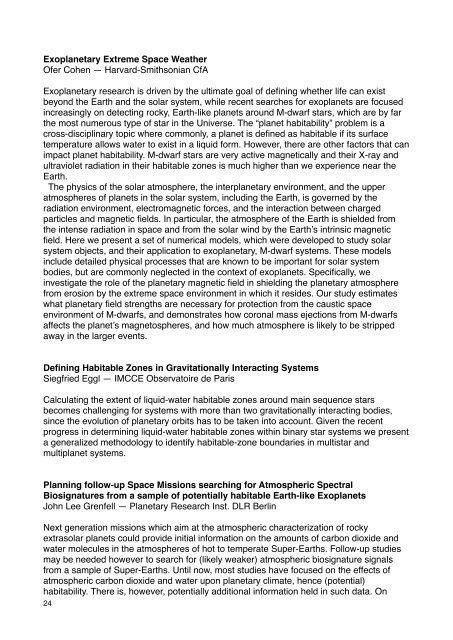Exoclimes_Conference_booklet1
Exoclimes_Conference_booklet1
Exoclimes_Conference_booklet1
Create successful ePaper yourself
Turn your PDF publications into a flip-book with our unique Google optimized e-Paper software.
Exoplanetary Extreme Space Weather<br />
Ofer Cohen — Harvard-Smithsonian CfA!<br />
Exoplanetary research is driven by the ultimate goal of defining whether life can exist<br />
beyond the Earth and the solar system, while recent searches for exoplanets are focused<br />
increasingly on detecting rocky, Earth-like planets around M-dwarf stars, which are by far<br />
the most numerous type of star in the Universe. The “planet habitability” problem is a<br />
cross-disciplinary topic where commonly, a planet is defined as habitable if its surface<br />
temperature allows water to exist in a liquid form. However, there are other factors that can<br />
impact planet habitability. M-dwarf stars are very active magnetically and their X-ray and<br />
ultraviolet radiation in their habitable zones is much higher than we experience near the<br />
Earth.<br />
The physics of the solar atmosphere, the interplanetary environment, and the upper<br />
atmospheres of planets in the solar system, including the Earth, is governed by the<br />
radiation environment, electromagnetic forces, and the interaction between charged<br />
particles and magnetic fields. In particular, the atmosphere of the Earth is shielded from<br />
the intense radiation in space and from the solar wind by the Earth’s intrinsic magnetic<br />
field. Here we present a set of numerical models, which were developed to study solar<br />
system objects, and their application to exoplanetary, M-dwarf systems. These models<br />
include detailed physical processes that are known to be important for solar system<br />
bodies, but are commonly neglected in the context of exoplanets. Specifically, we<br />
investigate the role of the planetary magnetic field in shielding the planetary atmosphere<br />
from erosion by the extreme space environment in which it resides. Our study estimates<br />
what planetary field strengths are necessary for protection from the caustic space<br />
environment of M-dwarfs, and demonstrates how coronal mass ejections from M-dwarfs<br />
affects the planet’s magnetospheres, and how much atmosphere is likely to be stripped<br />
away in the larger events.<br />
Defining Habitable Zones in Gravitationally Interacting Systems!<br />
Siegfried Eggl — IMCCE Observatoire de Paris!<br />
Calculating the extent of liquid-water habitable zones around main sequence stars<br />
becomes challenging for systems with more than two gravitationally interacting bodies,<br />
since the evolution of planetary orbits has to be taken into account. Given the recent<br />
progress in determining liquid-water habitable zones within binary star systems we present<br />
a generalized methodology to identify habitable-zone boundaries in multistar and<br />
multiplanet systems.<br />
Planning follow-up Space Missions searching for Atmospheric Spectral<br />
Biosignatures from a sample of potentially habitable Earth-like Exoplanets!<br />
John Lee Grenfell — Planetary Research Inst. DLR Berlin!<br />
Next generation missions which aim at the atmospheric characterization of rocky<br />
extrasolar planets could provide initial information on the amounts of carbon dioxide and<br />
water molecules in the atmospheres of hot to temperate Super-Earths. Follow-up studies<br />
may be needed however to search for (likely weaker) atmospheric biosignature signals<br />
from a sample of Super-Earths. Until now, most studies have focused on the effects of<br />
atmospheric carbon dioxide and water upon planetary climate, hence (potential)<br />
habitability. There is, however, potentially additional information held in such data. On<br />
24


